
By Mike Mason
In the fire service, it has been ingrained in us that almost every structure should be searched for civilians. The decision making related to the presence of occupants and their rescue is one of our main fireground responsibilities. Such a dangerous task requires extensive training, sound size-ups, and drawing on related search experience. Every search differs from one residential fire to another. To ensure that we save lives and protect our firefighters, we must consider the following:
- The risk vs. benefit related to survivability for the civilian and the firefighter.
- The life occupancy and the priority areas in search size-ups including the time of day before and during searches.
- Search tools.
- The search team’s size and experience.
- The search techniques and their applicability for various types of searches.
- The accuracy and the speed of primary and secondary searches.
- Applications and door control with both oriented searches and vent-enter-isolate searches (VEIS).
- The search and the fire flow paths.
- The applicability for victim rescue and removals.
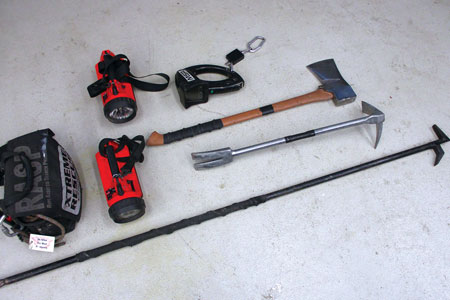 |
| (1) The basic tools of search: flathead ax, halligan bar, two flashlights, looped webbing, rope bag for larger residences, and a New York Hook. Use the hook only to help extend into a room to reach and close and control doors. Do not drag pike poles and New York hooks around in residential searches. (Photos by author.) |
Consider the above basic principles and techniques in deciding whether to commit firefighters to search any structure’s interior. Once they come across a victim, they face the additional challenges of rescuing him, which may mean moving a victim through a high-hazard environment, risking depleting their self-contained breathing apparatus (SCBA) air, and becoming confused and disoriented as they position and move the victim.
Once victims are found, their level of mobility (i.e., conscious or unconscious) demands using specific techniques to extricate the victim and to ensure firefighters can extricate themselves. Regardless of the type of search, search and rescue requires diligent communications among the search team members and between the search team and outside incident command. Firefighters must also establish an orderly and complete search, often under zero-visibility conditions, to the best of their abilities. Maintaining orientation during search is another challenge.
Training and Experience
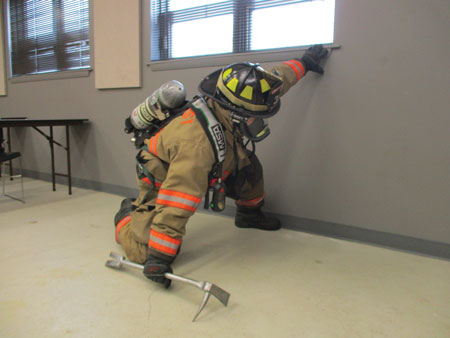 |
| (2) Searching and staying low because of conditions require orientation to a wall to help facilitate locating windows. Sweep high while holding the halligan bar to the ground in the opposite hand. Reach wide and sweep with the tool as you move forward. If you need to investigate something you may have found, feel it with a gloved hand. Use hands to identify victims, not tools. |
The initial firefighter recruit training techniques emphasize maintaining contact with walls and orienting your search to the left or to the right. However, this alone is inadequate for the residential search environment. The seasoned firefighter will find these early training methods are too slow and waste valuable time. Victims need immediate assistance, and firefighters need to move quickly into a structure, as threatening fire conditions are possibly deteriorating, reducing the victim survivability profile. Firefighters’ searches must be as quick and as extensive as possible. Staying stuck to a wall is not conducive to a good search, nor is it always possible to maintain contact with a wall because of the room layout and furnishings in a residence. Using appropriate search methods increases the victim’s chances for survival.
The bedrooms and common passageways to and from them are the most likely locations of occupants, especially during the evening or early morning hours. In doing a primary search of these areas, use systematic and rapid movements. You can do a solid primary search of most bedrooms in about 20 to 30 seconds – one rescuer searches while the other rescuer monitors at the room’s entrance. The rescuer at the door verbally keeps the other rescuer oriented during his search. The door member also monitors fire conditions and plans an exit strategy with or without a victim if there is a need for rapid egress.
Sound Search Considerations
 |
| (3) Positioning your tool into the wall enables you to extend your reach and investigate farther into areas. Remember, if at any given point during a residential search you are driven off the wall of orientation, you can apply this technique also off furniture to help with orientation. |
- Use reliable information to locate victims.
- Consider the type of room.
- Use a minimum of two firefighters, one searching/one monitoring.
- Move into the room toward the swing side of the door.
- Place your tool at the door or at an angle on the inside of the wall opposite the swing side of the door.
- Under threatening fire conditions, control and close the door to protect the search.
- Incorporate coordinated window ventilation with door control in a room when appropriate.
- When using VEIS, control/close the door.
- When searching in bedrooms, sweep the bed, around it along the floor, and underneath it. Search bunk beds at the top bunk first, move down to the next bunk, and finally under the bottom bunk at the floor. Do not move the bed or mattress to search under it.
- The monitoring firefighter provides illumination with a flashlight at the door. In limited visibility, both firefighters must maintain good voice contact.
- If no victims are found, close the door when leaving or when needed to maintain or avoid altering the fire flow path.
- When performing VEIS in limited visibility or in threatening fire conditions, limit the search to one room; exit from the window onto the ladder.
- If and when victims are found, immediately notify the incident commander (IC) while also requesting additional help and communicating the intended path of travel to the exit chosen for both firefighters and victims.
Many tactical and performance techniques should be acquired and applied to searching for civilians in residential structures. Through search experience and training, firefighters are always developing new and improved maneuvers to help improve communication, accountability, and orientation in near-zero visibility environments.
Victim Locations
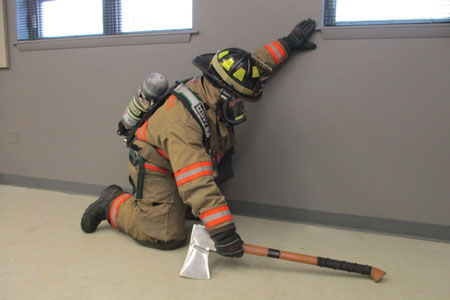 |
| (4) The position of the flathead ax when searching low. Sweep the floor ahead and to the side as you go, keeping the handle forward while the blade is positioned toward the floor. |
Based on live residential fire experience, focus searches on high-life hazard areas while monitoring for fire conditions, fire flow paths, and egress. Civilians (conscious and unconscious) will be found in the following areas within residential structures:
- Just beyond the entry and the exit doors.
- Behind the swing side of doors.
- Along common passageways leading to rooms or staircases.
- In bedrooms, especially in the evening and early morning hours.
- In bathrooms, where they seek protection, thinking that water is available to protect them.
- In closet areas, especially children.
- In nursery rooms.
Tools
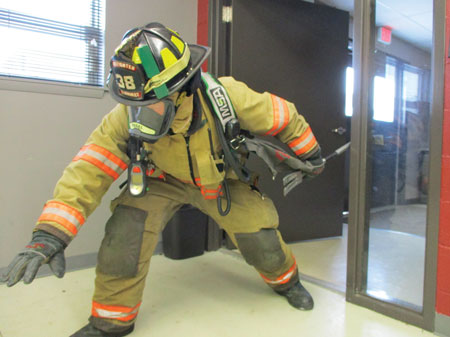 |
| (5) You can use the halligan bar or a New York hook to help extend yourself into a room while in zero visibility to help investigate the layout and to help reach possible victims. |
Firefighters should bring the appropriate search tools. However, even when using them for probing and sweeping, use a gloved hand to confirm the presence of a victim. Use your hands, not the tools, to locate and find distressed civilians. The type of search and the residential structure features dictate the tools to use. Following are basic tools required for search and for firefighter survival:
- Full personal protective equipment (PPE)/SCBA.
- Portable radio.
- Halligan bar/ax/irons.
- Two flashlights.
- Thermal imaging camera (TIC).
- Looped webbing for drags/survival.
- Hoseline protection.
- Ladders for VEIS, ingress, and egress.
- Six-foot New York hook for VEIS when applicable.
- 150-foot small-diameter rope bag for complex structures or those more than 3,000 square feet in area.
These tools enable you to probe ahead, extend your reach into rooms and off walls, and locate objects of interest/possible victims when investigated with your gloved hand. Using these tools improperly can also injure victims and firefighters. Used as anchors, they can help you extend farther into a room, but this technique will result in a limited search of a room instead of complete coverage.
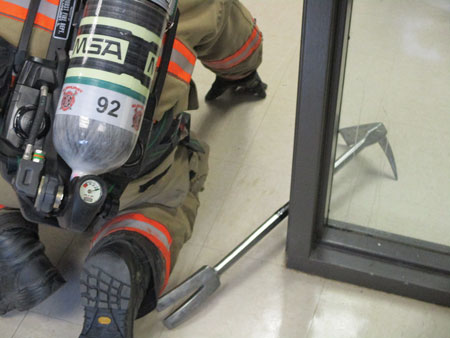 |
| (6) When entering room areas, leave your tool at the door entrance; lay it on the floor halfway in and halfway out next to the jamb. |
The halligan bar is a versatile search and firefighter survival tool if used appropriately. Because of its design and weight, drag the halligan along the floor with the pike/adz end ahead resting on its points and the fork facing behind. Grip it in the middle of the bar so as to keep your knuckles off the floor while moving it along. Use this method when visibility is poor. Waving it around in front of you is ineffective, is tiring, and could seriously injure a civilian or firefighter who may come in contact with it.
When using the ax, hold it with your gloved hand near the ax head and blade, and point the long handle ahead of you. Regard any search tool as a victim locating tool and as a survival tool for wall breaching, forcible entry, and possibly an anchor for bailouts.
Furniture
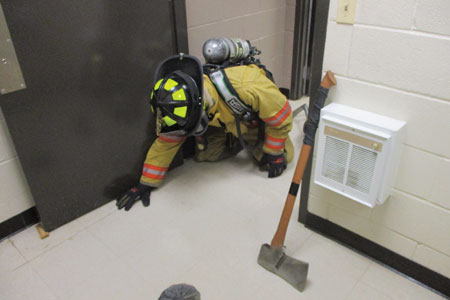 |
| (7) Alternately, prop it up on an angle just inside the door. Always move first to the swing side of the door, when possible, with the tool placed on the opposite side. This facilitates better orientation when returning to the door entrance after going around the room. |
Searching certain furniture and the furnishing arrangements under fire conditions takes training and experience. Searching king beds, queen beds, bunk beds, under windowsills, and in different closet types/configurations is challenging in near-zero visibility. Don’t carelessly throw or move furniture around when searching; it will cover areas that have not been searched yet and remove landmarks that enable searching firefighters to return the way they came. Furnishings inside residential structures offer landmarks that aid the searchers in mentally mapping a room and their placement in it. Firefighters can thus extend their search deeper into the room and return to a wall if necessary.
Ventilation
Searching in zero visibility for long periods increases the risk to firefighters and reduces the chances of victim survivability. When rescuers can ventilate, they should do as soon as possible to increase the speed and accuracy of the search. However, before doing so, they must consider the flow path of fire and smoke, especially when searching without a hoseline. Regardless of whether a hoseline is brought in by the search team or an engine company making a good advance on the fire, when combined with top-side ventilation when possible, it will improve conditions and thus survivability for all firefighters and civilians inside the structure. This, along with good communications and coordinated ventilation, will ensure a more productive search.
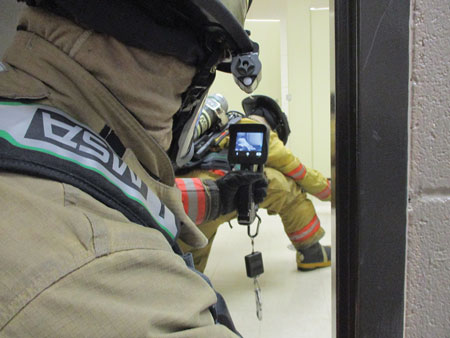 |
| (8) Ideally, have the control member at the door with a thermal imaging camera (TIC) if possible as the other member searches. This may not always be possible because of limited time, or a TIC may be unavailable. Remember voice communication is imperative to stay oriented and safe. |
Searching Ahead of the Hoseline
When searching under fire conditions, firefighters should try to get to the area closest to the seat of the fire when possible. An engine company that is advancing a line to the fire can search only after it has arrived at the seat of the fire. While the nozzleman holds the fire in check, then and only then can members conduct a search off the hoseline. Conducting a primary search while members are advancing a line to the seat of the fire would be nearly next to impossible to consider as an effective primary search. Encountering a victim while advancing a line requires a whole new set of strategies to keep the line moving while also trying to move and rescue the victim or hand him off to another assisting company.
Searching ahead of the hoseline can in some cases provide for a more effective search in regard to the reflex time vs. waiting for a hoseline to get ahead of a search, but those preparing to search should weigh this judiciously. Getting to occupants sooner may increase the survivability profile in their rescue, but it also carries with it the possibility of diminished survivability of the searchers, who will be exposed to more severe fire conditions. Another aspect is that the visibility may improve in the search areas closest to the fire because of the light that may be provided by the flames. Getting to the area where victims are most threatened from the hostile environment will allow searching firefighters to move farther away as they progress their search back toward their egress points. Search teams that move in ahead of hoselines can communicate to ICs and engine companies their location and direction of travel to the seat of the fire. Employing such maneuvers carries a greater risk to those searching, but they may also help in executing complete primary searches along with improving earlier fire control and scene stabilization. Searching firefighters must try to provide a swift well-paced complete search while always remaining aware that rapidly changing fire conditions can become out of control.
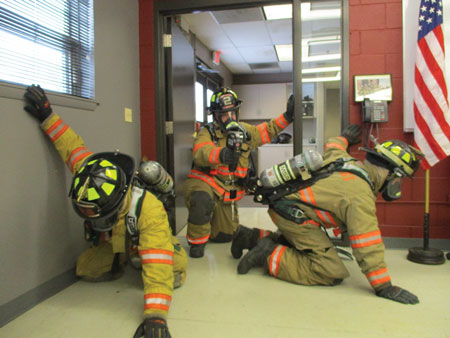 |
| (9) Ideally, if three rescuers are available for larger areas, position a control member at the door with the TIC as the other two rescuers navigate the larger area. The control man with the TIC and voice communication can keep the search oriented and enable the searchers to safely return to the door. |
Fire Flow Path and Search
Most of our traditional search training has been based on fire conditions as they existed in the days of natural materials and legacy construction. Today’s fire environment has drastically changed. The modern structure fire is usually ventilation limited with high heat release rates from synthetic materials and a shorter time to flashover and collapse.
Search methods today must consider the fire flow path that existed prior to our arrival and the flow paths we create during the fire. The search maneuvers usually taught have one firefighter searching within a room while another firefighter/fire officer stays in the open doorway monitoring local fire conditions and the searching rescuer. Recent studies on fire flow paths indicate it may sometimes be better to search an area with the door closed with the monitoring firefighter outside the closed door waiting for the searcher to return. Protecting the search is primarily to protect civilians and firefighters from smoke and heat whenever possible. Controlling the door and keeping it closed may buy more time for the occupants and firefighter’s air supply and also possibly limit the fire’s flow path to the search area. Combining these considerations with a TIC and a good hand light will allow the rescuer to search farther and more accurately.
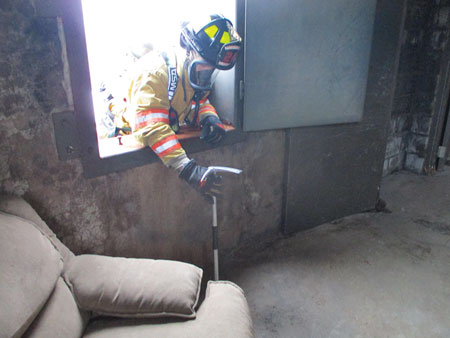 |
| (10) During vent-enter-isolate-search (VEIS) operations, sweep and sound the floor with a tool before entering. Sweeping carefully first allows you to initially find victims and avoid injuring them. After sweeping, sound the floor. |
Primary searches incorporating two to three rescuers require searchers to work off the walls in most cases, allowing rescuers to reach and feel farther into the room’s center, increasing the chance of identifying and rescuing victims. When proceeding to the rooms closest to the fire, make every attempt to close the door to the fire room to isolate it and avoid disrupting the fire flow path. From this point, the searchers would search as systematically as possible – first the rooms closest to the fire, the most threatened areas with low victim survivability – and then move to the rooms farther away.
Open areas and hallways in line with flow paths are the most dangerous places to search because of the higher temperatures and intensified fire conditions resulting from previous ventilation openings or newly created ones. Fire officers controlling the searches are better off monitoring these areas with flashlights and TICs while searching firefighters check behind closed doors. Just before firefighters enter the rooms to be searched, the control firefighter and the searching firefighter should scan the room with the TIC. The control officer should then allow the searching firefighter to enter the room to begin the search while closing the door and controlling it. This may also allow the searching firefighter within the room to possibly ventilate a window for increased visibility and survivability for both the victim and himself. The control officer can periodically open the door to monitor the search and the hallway areas for smoke and fire conditions and the effects of the fire flow path. If for any reason a door cannot be controlled, ventilation is not advised.
Tactical VEIS Considerations
 |
| (11) During VEIS, the second rescuer up the ladder resides at the window when possible with the TIC and voice communications to the interior rescuer searching. |
VEIS involves searching above a fire through a window entry at residential fires, bypassing the interior stairs. This tactic can be valuable and has saved many civilian lives; but when inappropriately applied, it has endangered firefighters. VEIS should not replace the conventional interior search methods in which the home is entered at ground level; this approach allows searchers to cover many bedrooms and other areas vs. using VEIS, in which only one bedroom or area is covered. During VEIS procedures, firefighters would have to return to the ladder, descend, and reposition the ladder to another window to repeat the process.
Recent research has shown how ventilation openings create flow paths and that door control is critical. We now know that when performing VEIS, breaking windows must be weighed against the potential for causing unintentional ill effects for civilians and firefighters alike. Critical considerations in performing this tactic are the fire location, the time, the fire flow path, and the wind. Because of modern lightweight construction and the fact that residential furnishings made of synthetics burn faster and hotter enabling the fire to quickly spread to any given ventilation point, the decision of whether to perform VEIS should be based on a risk/benefit analysis of the possibility that the fire will spread into a bedroom vs. the potential of saving of a life. Timing is critical; once a window is broken, the race is on for the firefighter performing VEIS to enter and close the bedroom door before the fire reaches it. The time it may take firefighters to prepare to enter the structure – masking up, gathering tools, getting up the ladder, and then clearing the rest of a window out – may allow the fire’s flow path to enter a room or area and compromise the search.
The following method minimizes the time lapse between breaking a window and closing a bedroom door.
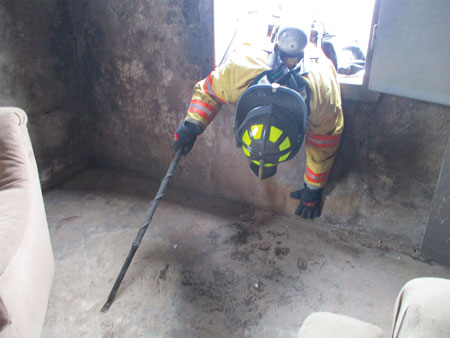 |
| (12) When entering a window, use a New York hook, halligan, or other tool to help balance yourself while entering when a low profile is required. |
Ladder windowsill ventilation. Position the ladder in the rescue position with the tips of the beams just below the sill. The firefighter on the ladder should keep his head below the level of the windowsill and use the reach of a six-foot hook to break the window. The advantages are the ladder is in ready position for VEIS entry, and the firefighter is below the outward flow of smoke and fire since he is just underneath the sill and his reflex time getting into the window is very short. Clearly, a firefighter who breaks a window while positioned directly below it risks being cut by falling glass, but the risk must be weighed against the potential benefit of saving a life. Additionally, wearing full PPE and SCBA can minimize the effects of falling glass.
With any of these procedures or techniques, VEIS can allow the fire flow path to affect the area of the vent from an open interior bedroom door before the firefighter can get to the door to control it. Nonetheless, our job is to save lives when lives are in the balance. The risk is great for firefighters and civilians, but the reward is greater even if we recover a victim who has not survived. The fire flow path should not deter our efforts in saving lives. When firefighters perform VEIS, they must quickly get up the ladder, through the window, and into the room. Getting in and out of a window wearing SCBA and carrying tools can be difficult. Depending on conditions, firefighters may straddle a window or even belly down over the windowsill while getting in. The techniques and concerns when entering windows under VEIS applications are listed below.
- Is interior stair access more viable?
- Sound the floor carefully with a tool; a victim may be present just below the windowsill.
- Depending on conditions, enter by straddling the window or use belly-down techniques.
- Control your tools.
- Use tools to extend yourself from the windowsill into the room.
- Leave tools at the window on an angle to help your return to the window in zero visibility.
- Quickly get to the door of the room to control the door.
- If conditions permit, search just beyond the door into the immediate hallway.
- Close the door to the room and begin a systematic search.
- If a victim is located, communicate this to your partner and the IC.
- Call for additional help.
- If no victims are present, leave the room by the window you came through onto the ladder and then to the ground.
- Rotate the ladder against the building to the next window and repeat the above process.
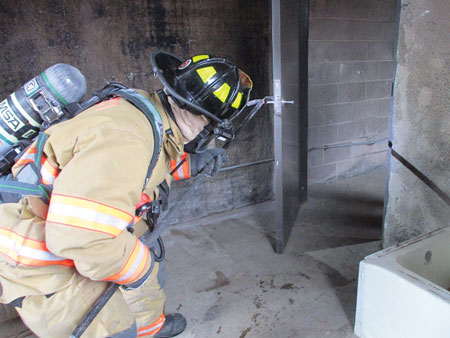 |
| (13) Use the New York hook or any tool to control the door on entry in a VEIS tactic to facilitate and control fire flow path. Remember, when possible, to check just beyond the door into the hallway for possible victims. |
It is important to focus on ventilating a window to access a floor above. Communicate with fire companies advancing a line for extinguishment, and coordinate search line advancement. Venting an upper-floor window may provide some lift and heat release for advancing hoselines, but it may also draw heat and fire to the vented window. A judicious decision process must be made in a very fast-paced dynamic environment when lives are in the balance.
Basements
Searching in basement fires is nothing short of treacherous if attempted without a hoseline and water application before descending the basement stairs. These fires and the search for occupants in these areas must be addressed much differently than other coordinated behaviors on the fireground at structural fires. It is next to impossible for searching rescuers to expect positive outcomes when we have few options regarding the intense fire flow paths found at these types of fires. Exposing oneself to the hot gases, smoke, and flame while trying to descend the basement stairs is not practical, and you should not assume that the occupant will survive. The probability that searching rescuers will be in harm’s way is very high because of the crumbling condition of the interior basement stairs, which may be exposed to flame impingement underneath.
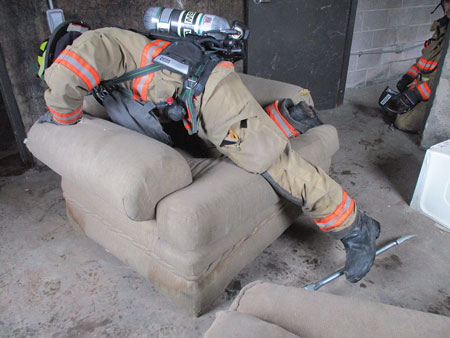 |
| (14) When searching furniture such as couches and large beds, be sure to get on them and sweep when possible, and be sure to leave your tool secured on the floor. |
There are several reasons primary search in basement fires should be attempted with caution or even delayed until the fire is under control. Many times, combustible products are stored in the basement; they increase the possibility of high heat release and fast-moving fires. In addition, the gas and electrical services present are not usually under control when these fires occur. Moreover, various storage items and clutter may be present, making it extremely difficult for search crews to navigate and be able to reference the exit.
Many times, the only way out of the basement is the interior stairs. Basement access is limited, and so is egress for any search group attempting primary search, especially before fire control is established. Again, make no attempt to save lives in basements under fire conditions without a hoseline and applying water to the main body of fire. If there is another access point, such as an exterior entrance as an outback, this would be the correct avenue for hoseline crews and searchers.
With basement fires, the only strategy to consider based on fire conditions is to perform ventilation and apply water from the exterior before attempting to go down the interior basement stairs. This applies to both engine and search crews. Additionally, always use two operating hoselines for exterior knockdowns and for front door advancement to the interior basement stairs to provide protection for extinguishment and search strategies, not only for the basement but for the rest of the structure above the fire as well. Like most searches for occupants, basements can create some of the most hostile searches for rescuers just as VEIS and searching above the fire can.
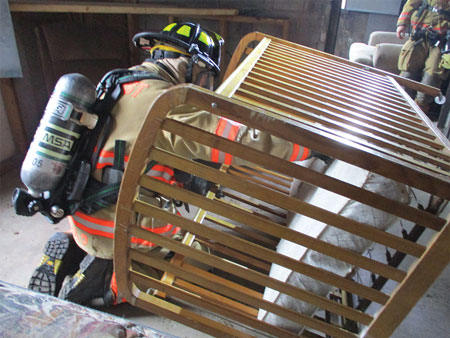 |
| (15) When discovering cribs, try to angle the crib downward to allow the infant or toddler to roll toward your grasp to avoid standing in heat and smoke conditions and exposing the victim and yourself. |
All the avenues regarding the strategies and tactics of search necessitate sound decision making based on knowing where victims are located and their probability of survival, along with search training. Train as often as possible within vacant buildings and acquired structures. Set up scenarios with realistic environments that include furniture settings and near-zero visibility conditions using smoke machines or smoke barrels. By training, we can increase the odds of finding and locating victims and facilitate their rescues.
MIKE MASON is a retired 31-year fire service veteran. He was a lieutenant with the Downer’s Grove (IL) Fire Department, assigned to Truck 2/Squad 2. He is a certified instructor III and fire officer II and has an associate degree in fire science and master’s certificates in strategic and organizational leadership from several universities. Mason is the director of and an instructor with RicoFireRescue Inc.
Search and Rescue Above the Fire
Searching in the Flow Path
Residential Search and Rescue Carries and Drags
RESIDENTIAL SEARCH AND RESCUE: Methodology
Fire Engineering Archives

